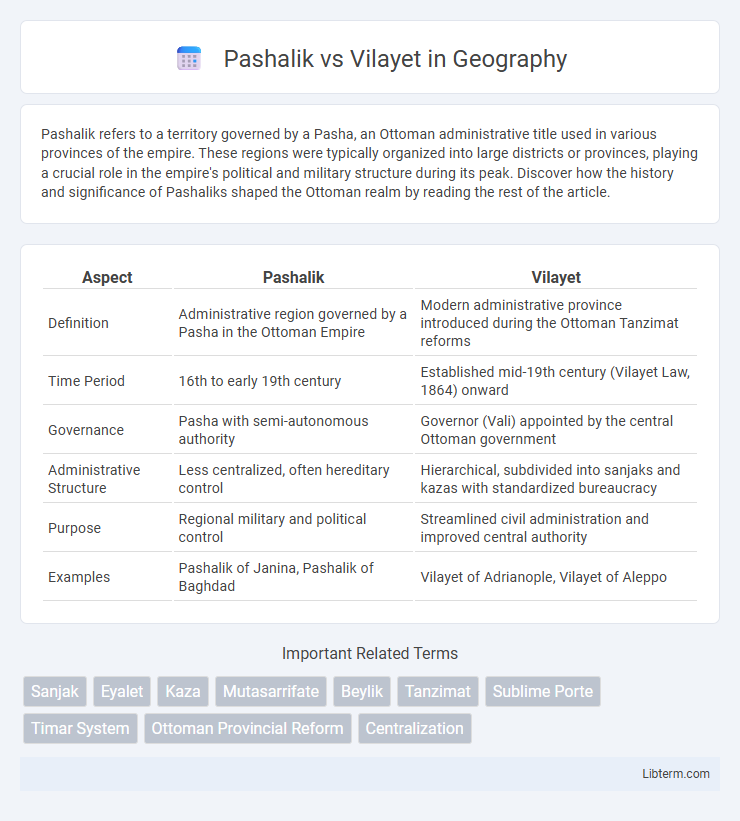Pashalik refers to a territory governed by a Pasha, an Ottoman administrative title used in various provinces of the empire. These regions were typically organized into large districts or provinces, playing a crucial role in the empire's political and military structure during its peak. Discover how the history and significance of Pashaliks shaped the Ottoman realm by reading the rest of the article.
Table of Comparison
| Aspect | Pashalik | Vilayet |
|---|---|---|
| Definition | Administrative region governed by a Pasha in the Ottoman Empire | Modern administrative province introduced during the Ottoman Tanzimat reforms |
| Time Period | 16th to early 19th century | Established mid-19th century (Vilayet Law, 1864) onward |
| Governance | Pasha with semi-autonomous authority | Governor (Vali) appointed by the central Ottoman government |
| Administrative Structure | Less centralized, often hereditary control | Hierarchical, subdivided into sanjaks and kazas with standardized bureaucracy |
| Purpose | Regional military and political control | Streamlined civil administration and improved central authority |
| Examples | Pashalik of Janina, Pashalik of Baghdad | Vilayet of Adrianople, Vilayet of Aleppo |
Introduction to Pashalik and Vilayet
Pashalik refers to an administrative division in the Ottoman Empire governed by a Pasha, typically characterized by semi-autonomous rule with military and fiscal authority. Vilayet emerged in the 19th century Ottoman reforms as a more centralized provincial structure aimed at modernizing administrative efficiency and governance. The Vilayet system divided provinces into smaller districts with appointed officials to enhance direct control and reduce local autonomy compared to the Pashalik framework.
Historical Origins of Pashalik
The Pashalik system originated in the 16th century Ottoman Empire as territorial jurisdictions governed by a Pasha, serving as administrative and military centers. These units were precursors to the more centralized Vilayet system introduced in the mid-19th century Tanzimat reforms to improve administrative efficiency and provincial governance. The transition from Pashaliks to Vilayets marked a significant evolution in Ottoman decentralization and modernization efforts.
Emergence of the Vilayet System
The Vilayet system emerged in the late 19th century as an administrative reform within the Ottoman Empire, replacing the older Pashalik structure to enhance governance efficiency and centralization. Unlike the semi-autonomous Pashaliks governed by Pashas, Vilayets were standardized provinces led by appointed governors (Valis) under direct imperial control. This system aimed to modernize administration, improve tax collection, and reduce local power abuses, marking a significant shift in the Ottoman provincial organization.
Administrative Structure of a Pashalik
A Pashalik was an administrative division in the Ottoman Empire governed by a Pasha, functioning with considerable autonomy and military authority, often encompassing multiple districts or sanjaks. Its administrative structure centered around the Pasha, who exercised both civil and military control, supported by local officials such as the defterdar (treasurer) and kadi (judge). Unlike the more standardized Vilayet system introduced later to centralize governance, Pashaliks often displayed varied administrative practices reflecting regional power dynamics.
Administrative Structure of a Vilayet
A Vilayet, established during the Tanzimat reforms in the Ottoman Empire, featured a more centralized and hierarchical administrative structure than the earlier Pashalik system. It was governed by a Vali (governor) supported by councils like the Meclis-i Idare, ensuring greater coordination in regional governance. This organization improved administrative efficiency by dividing responsibilities among sub-governors (Mutasarrifs) of districts (Sanjaks), standardizing tax collection, law enforcement, and public services.
Key Differences Between Pashalik and Vilayet
Pashalik and Vilayet were both administrative divisions in the Ottoman Empire, but Pashaliks were governed by Pashas with more autonomous control, often hereditary or semi-independent, while Vilayets were larger provinces established during the Tanzimat reforms with a structured, centralized administrative system. Vilayets were organized to improve governance efficiency and included subdivisions like sanjaks and kazas, reflecting modernization efforts in the 19th century Ottoman administration. The key difference lies in the level of central control and administrative organization, with Vilayets representing a more standardized imperial bureaucracy compared to the more autonomous and localized rule of Pashaliks.
Governance and Authority Roles
Pashaliks functioned as semi-autonomous territories governed by a Pasha who held both military and administrative authority, often exercising considerable independent control under the Ottoman Empire. Vilayets, established later through administrative reforms, operated as formal provincial units with a structured bureaucracy led by a vali (governor) appointed by the central Ottoman government, ensuring centralized oversight and standardized governance. The key distinction in authority lies in the Pasha's autonomous governance compared to the Vilayet's hierarchical administration designed to integrate provincial rule with imperial policies.
Impact on Regional Autonomy
Pashaliks, as semi-autonomous provinces within the Ottoman Empire, allowed regional leaders significant control over local administration and military affairs, fostering strong regional autonomy. Vilayets, introduced in the 19th-century Tanzimat reforms, standardized governance under centrally appointed governors, significantly reducing the autonomous powers of regional authorities. The transition from Pashalik to Vilayet marked a shift towards centralization, limiting regional self-governance and enhancing direct control from Istanbul.
Reforms and Decline of Pashalik and Vilayet
Pashaliks, Ottoman administrative units governed by pashas, faced decline due to weak central control and ineffective reforms, leading to growing autonomy and regional fragmentation in the 18th century. In contrast, the later Vilayet system, established by the 1864 Vilayet Law, aimed to modernize administration through standardized provincial governance, improved tax collection, and infrastructural development, strengthening central authority. Despite reforms, both Pashaliks and Vilayets struggled with corruption and local resistance, contributing to the gradual weakening of Ottoman provincial administration.
Legacy and Modern Implications
Pashaliks, semi-autonomous provinces under Ottoman rule, laid foundational governance frameworks later refined by the more centralized Vilayets established in the mid-19th century through the Tanzimat reforms. The Vilayet system introduced standardized administrative divisions, enhancing bureaucratic efficiency and modern state control, influencing contemporary regional boundaries and administrative structures in former Ottoman territories. This evolution from Pashalik to Vilayet reflects a significant shift toward modernization and centralization, impacting present-day governance models and legal jurisdictions in countries such as Turkey, Syria, and Iraq.
Pashalik Infographic

 libterm.com
libterm.com